.xtbl virus (Quick Decryption Solution) - 2021 update
.xtbl virus Removal Guide
What is .xtbl virus?
XTBL virus is a ransomware that is a version of Scarab ransomware virus
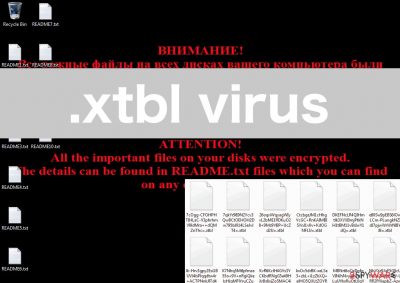
XTBL virus (otherwise known as the Troldesh Trojan) is ransomware that has been targeting all versions of Windows operating systems. Its aim is to lock down the most of personal victim's files using AES and RSA[1] encryption algorithm. This crypto-malware changes these files by adding a line of random numbers that indicate the victim’s ID and an email address pointing to the ransomware developer to their name. The ID numbers and emails tend to be different, but the final part of this lengthy extension is always the same – .xtbl file extension.
Initially, the ransomware appeared as a part of CrySiS malware family. However, this file extension was also reused by another broad malware strain known as Scarab. The malware was first released in April 2018, but security researchers spotted the increased activity two years later. The virus does not change names or adds user ID to files, but instead adds an extension to them. Additionally, the malware also drops IF YOU WANT TO GET ALL YOUR FILES BACK, PLEASE READ THIS.TXT ransom note, which explains that victims have to pay a ransom in Bitcoin in order to restore the locked data. Perpetrators also offer test decryption of two files to gain victims' trust.
Regardless of which virus version you have been infected with, we highly discourage you from contacting the attackers. They might never provide you with the required key, so you could lose your money as well. Instead, we recommend you follow our ransomware removal guide and then use alternative methods when attempting to restore your files – we provide tips below.
| Name | XTBL virus |
|---|---|
| Type | Ransomware |
| Danger level | High. Can lead to permanent data loss |
| Cypher used | AES-265 and RSA (depending on the version) |
| File extension | .xtbl |
| Associated emails | green_ray@india.com, JohnyCryptor@aol.com, ecovector3@aol.com, gerkaman@aol.com, veracrypt@india.com, Okean-1955@india.com, joxe1@cock.li |
| Distribution | Malicious attachments, hacked or compromised sites, illegal software repacks, etc. |
| Elimination | Perform a full system scan with powerful anti-malware software, such as SpyHunter 5Combo Cleaner |
| System fix | Some Windows functions might break after the infection is eliminate or the system might begin crashing constantly. If you suffer from these issues post-infection, download and install FortectIntego |
There are many different types of ransomware and the newest addition to this group of viruses is Scarab-XTBL. This version is an updated variant of Scarab Ransomware which appends the same extension as its predecessors – .xtbl. As soon as the encryption process is complete, the virus generates a ransom note called “IF YOU WANT TO GET ALL YOUR FILES BACK, PLEASE READ THIS.TXT” and places it into each directory that contains infected files.
Sadly, the changed extension is just the tip of the iceberg compared to the problems you will have to deal with if this virus ever hits your PC. This virus is a ransomware-type program, so it uses the file encryption technique to extort money from its victims. In other words, it locks the files with a sophisticated algorithm that is virtually uncrackable, unless, of course, you have a private key.
Unfortunately, this key is stored on some remote, well-protected server. And, as you may already suspect, cybercriminals are not willing to hand this key in that easily. In exchange, the hackers demand a considerable amount of money.
Remember that paying up is the last thing you should do, because you may easily get scammed and lose your money. The better choice is to remove .xtbl ransomware virus from the computer as soon as possible to avoid additional damage. virus-fighting utilities such as SpyHunter 5Combo Cleaner, Malwarebytes can be used for this purpose. Also, employing FortectIntego could help you fix virus damage on the compromised system.
When the ransomware virus encrypts the data, it creates a README.txt document on every folder containing corrupted data. Instead of your regular desktop screen, you will also see a note, encouraging you to read the README document.
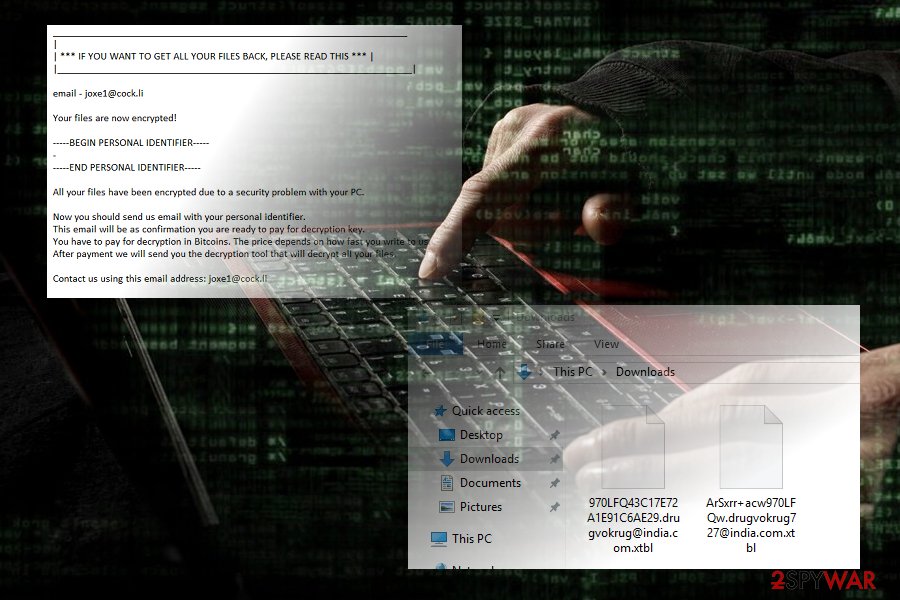
In this file, the cybercriminals provide the user with an identification code and two different email addresses, to which this code has to be sent in order to recover the files. It is interesting that the notes are bilingual and feature the same information in Russian and English, respectively:
Ваши файлы были зашифрованы.
Чтобы расшифровать их, Вам необходимо отправить код:
[random numbers] на электронный адрес decode010@gmail.com или decode1110@gmail.com.
Далее вы получите все необходимые инструкции.
Попытки расшифровать самостоятельно не приведут ни к чему, кроме безвозвратной потери информации.All the important files on your computer were encrypted.
To decrypt the files you should send the following code:
[random numbers] to e-mail address decode010@gmail.com or decode1110@gmail.com.
Then you will receive all necessary instructions.
All the attempts of decryption by yourself will result only in irrevocable loss of your data.
As you can tell, the criminals are not very elaborate about the financial part of data recovery. This only suggests that more details about the payment and its transfer are provided only after the victim contacts the criminals. Nevertheless, looking at general ransomware practices, it can be presumed that the sum demanded the file recovery may vary from 0,5 to 4 Bitcoins.
But as we have already mentioned, paying the cyber criminals may be possible but not the wisest way to retrieve your data. Therefore, we recommend virus removal instead of using trusted security software like SpyHunter 5Combo Cleaner or Malwarebytes. You may later try to restore your files using data recovery tools, such as PhotoRec , R-Studio or Kaspersky virus-fighting utilities. However, we do not recommend keeping your hopes very high.
Different variants of this ransomware
green_ray@india.com.xtbl
Just like the is .xtbl ransomware, .green_ray@india.com.xtbl virus sneaks into the computer’s system undetected and encrypts the containing files. Similar to the first version, it will display a notification on the desktop, and more detailed information about the file recovery in the additional document creates on the encrypted folders.
By the way, the name of the ransom note differs from the .xtbl, so instead of README.txt, you will see How to decrypt your files.txt. Despite the minor differences, this virus is just as dangerous as the primary threat, so you have to remove it from your computer without a delay.
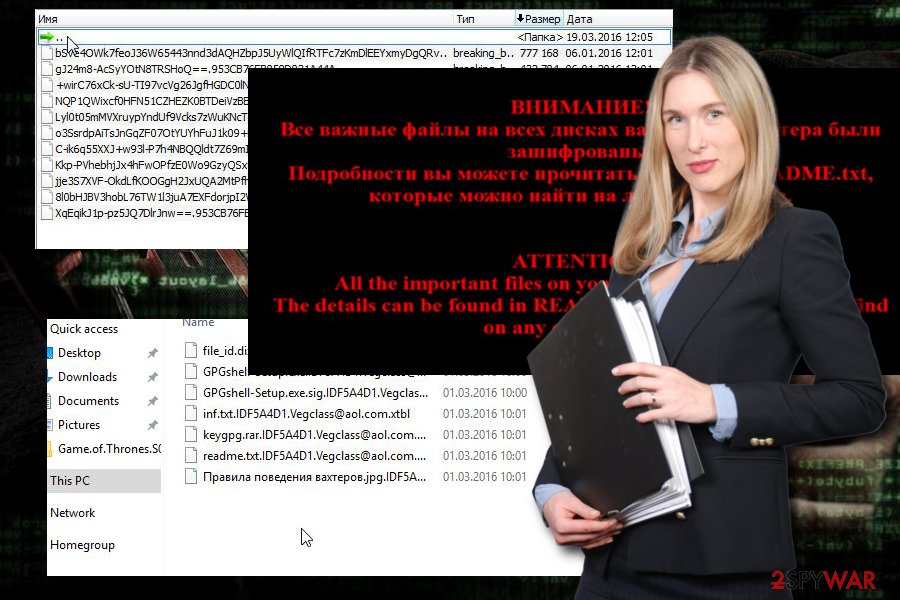
JohnyCryptor@aol.com.xtbl
This version of the virus is also practically identical to .green_ray@india.com.xtbl. It spreads through spam emails[2] and, once in the system, encrypts the files with a military-grade algorithm. It also uses the same How to decrypt your files.txt document to inform the victim about the file encryption and encourages the users to contact the cybercriminals via JohnyCryptor@aol.com email. Having this virus on your computer may negatively influence your system’s performance and pose a threat to your future files, so you have to remove JohnyCryptor@aol.com.xtbl from your computer as soon as you have the chance.
.ecovector3@aol.com.xtbl
Similarly to the .xtbl versions mentioned above, this virus enters the computer in deceptive ways, posing as a legitimate document or software update. In reality, as soon as this virus carrier settles on the computer, it starts scanning the system for files and encrypting data. None of your pictures, documents or archives are safe when this virus is around, so you have to get rid of it immediately when you notice you cannot access your files anymore.
gerkaman@aol.com.xtbl
gerkaman@aol.com.xtbl ransomware also encrypts data and invites the victim to contact the authors of the virus via email. Therefore, it is still unknown how much money they ask in exchange for a decryption key. We assume that they might be ready for negotiations. If your computer is infected with this virus, you should not even consider paying the ransom because most likely cybercriminals are not going to send it to you.
veracrypt@india.com.xtbl
veracrypt@india.com.xtbl is another version of the family of .xtbl viruses, though it acts similarly to the previous versions. By locking the victim's files, the virus can manipulate the user into transferring money for decryption and making an easy profit out of it. What is new with this version is that it offers the user to decrypt one file of their choice as a type of insurance. Otherwise, the virus does not differ much from its predecessors and is just as dangerous and fraudulent.
Okean-1955 ransomware virus
Okean-1955 ransomware virus is yet another ransomware that belongs to the particular virus family. This malware encrypts the victim's files, hides the decryption key in its command and control server, and asks to purchase it. The virus does not state the exact price of the decryption key; therefore, the victim has to send an email to Okean-1955@india.com and ask what is the price. For this reason, this malicious program has another name – Okean-1955@india.com ransomware. If you have detected this infection on your computer, remove it without any hesitation!
Scarab-XTBL virus
The malware has been spotted by MalwareHunterTeam[3] in April 2018. It is a new variant of Scarab ransomware, which adds the specific appendix to each of the files and demands a ransom to be paid in Bitcoins via a ransom note called “IF YOU WANT TO GET ALL YOUR FILES BACK, PLEASE READ THIS.TXT.” The note looks identical to the Scarab ransomware note and urges users to contact cyber crooks via joxe1@cock.li.
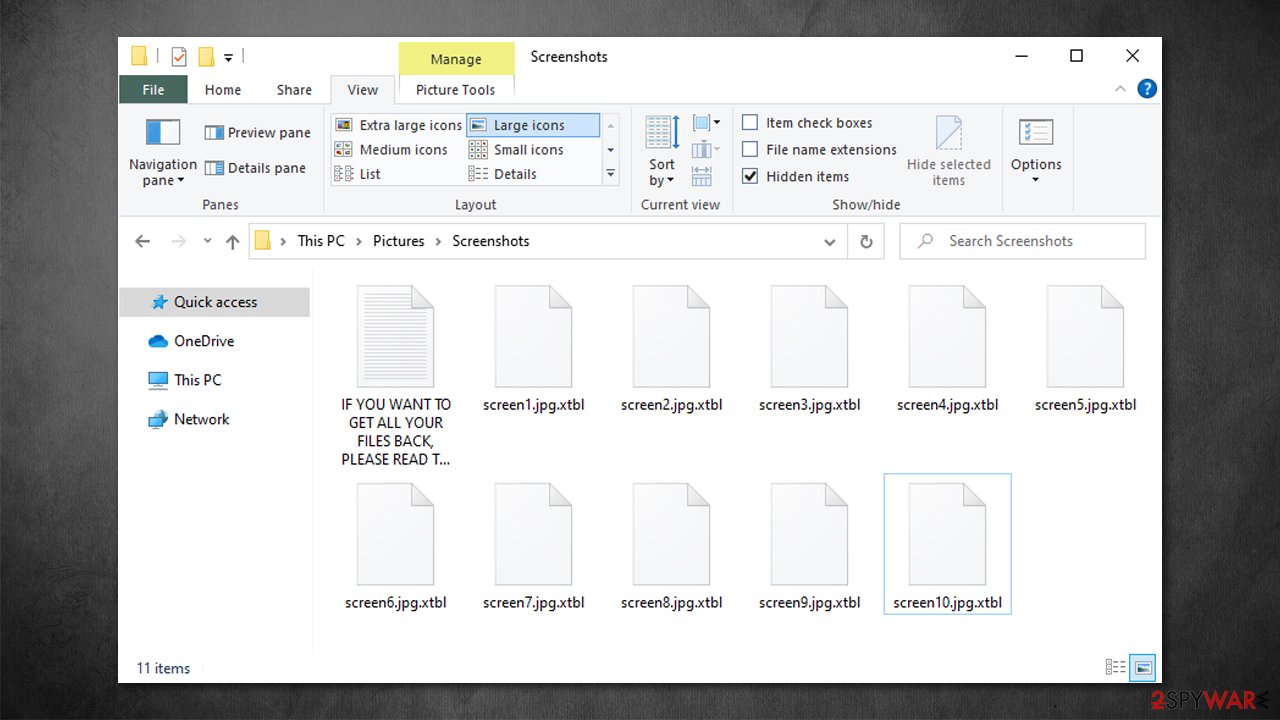
Ransomware is distributed mostly via spam emails
Ransomware viruses spread through spam emails mostly. It may appear as a legitimate file attachment at first, but in reality, there is a malicious script behind it. Usually, the virus spreads in JavaScript or Word format. If you accidentally download the first one, there is not much you can do to stop the virus as the JavaScript automatically activates the virus, and it starts its dirty work on your computer.
Word documents, on the other hand, may leave you some hope. This virus needs the Word macros script to activate itself, so if it is not enabled, the infection will not be able to spread. Although the virus may try to convince you to enable macros, you should not do that because this way, you will simply allow a malicious threat to enter your computer.
Therefore, security experts[4] urge users to be extremely careful when handling emails from unknown sources. If you see that the message has been flagged as spam – it is a high chance it is a malicious email. Thus, swiftly delete if from your inbox and never open attachments or click on provided links.
The virus can be removed using professional security software
What is especially unfortunate when talking about ransomware viruses is that they rarely leave the computers unharmed. Usually, the files remain locked and sometimes a full system overwrite needed to eliminate the consequences.
Unlike what most users think, the virus removal does not mean that the locked files will be decrypted. Nevertheless, it is crucial if you want to use your computer normally again. If some of the virus residue files are left on your PC, they may help the virus to bounce back to your computer or create system vulnerabilities allowing other malware to sneak in.
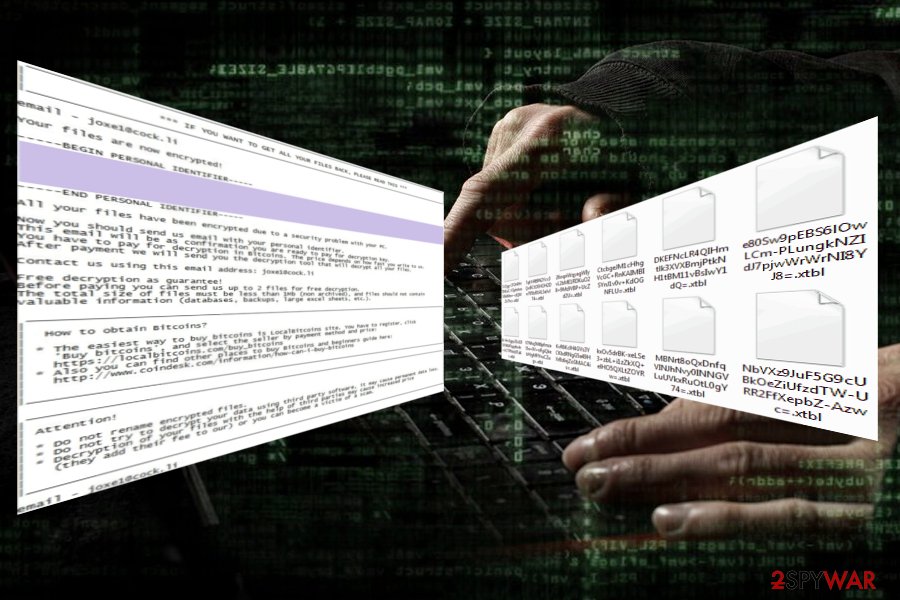
Therefore, to remove XTBL ransomware safely, you should employ the best security tools – we recommend SpyHunter 5Combo Cleaner or Malwarebytes. What you should keep in mind, though, is that malware may fight the antivirus and block its processes. In such a case, you can try completing the steps provided at the end of this article and running the scan again. If you experience crashes, lag, errors, and similar stability issues after you eliminate the infection, utilize FortectIntego to fix virus damage and remediate a Windows machine.
Getting rid of .xtbl virus. Follow these steps
Isolate the infected computer
Some ransomware strains aim to infect not only one computer but hijack the entire network. As soon as one of the machines is infected, malware can spread via network and encrypt files everywhere else, including Network Attached Storage (NAS) devices. If your computer is connected to a network, it is important to isolate it to prevent re-infection after ransomware removal is complete.
The easiest way to disconnect a PC from everything is simply to plug out the ethernet cable. However, in the corporate environment, this might be extremely difficult to do (also would take a long time). The method below will disconnect from all the networks, including local and the internet, isolating each of the machines involved.
- Type in Control Panel in Windows search and press Enter
- Go to Network and Internet

- Click Network and Sharing Center

- On the left, pick Change adapter settings

- Right-click on your connection (for example, Ethernet), and select Disable

- Confirm with Yes.
If you are using some type of cloud storage you are connected to, you should disconnect from it immediately. It is also advisable to disconnect all the external devices, such as USB flash sticks, external HDDs, etc. Once the malware elimination process is finished, you can connect your computers to the network and internet, as explained above, but by pressing Enable instead.
Scan your system with anti-malware
If you are a victim of ransomware, you should employ anti-malware software for its removal. Some ransomware can self-destruct after the file encryption process is finished. Even in such cases, malware might leave various data-stealing modules or could operate in conjunction with other malicious programs on your device.
SpyHunter 5Combo Cleaner or Malwarebytes can detect and eliminate all ransomware-related files, additional modules, along with other viruses that could be hiding on your system. The security software is really easy to use and does not require any prior IT knowledge to succeed in the malware removal process.
Repair damaged system components
Once a computer is infected with malware, its system is changed to operate differently. For example, an infection can alter the Windows registry database, damage vital bootup and other sections, delete or corrupt DLL files, etc. Once a system file is damaged by malware, antivirus software is not capable of doing anything about it, leaving it just the way it is. Consequently, users might experience performance, stability, and usability issues, to the point where a full Windows reinstall is required.
Therefore, we highly recommend using a one-of-a-kind, patented technology of FortectIntego repair. Not only can it fix virus damage after the infection, but it is also capable of removing malware that has already broken into the system thanks to several engines used by the program. Besides, the application is also capable of fixing various Windows-related issues that are not caused by malware infections, for example, Blue Screen errors, freezes, registry errors, damaged DLLs, etc.
- Download the application by clicking on the link above
- Click on the ReimageRepair.exe

- If User Account Control (UAC) shows up, select Yes
- Press Install and wait till the program finishes the installation process

- The analysis of your machine will begin immediately

- Once complete, check the results – they will be listed in the Summary
- You can now click on each of the issues and fix them manually
- If you see many problems that you find difficult to fix, we recommend you purchase the license and fix them automatically.

By employing FortectIntego, you would not have to worry about future computer issues, as most of them could be fixed quickly by performing a full system scan at any time. Most importantly, you could avoid the tedious process of Windows reinstallation in case things go very wrong due to one reason or another.
Restore Windows "hosts" file to its original state
Some ransomware might modify Windows hosts file in order to prevent users from accessing certain websites online. For example, Djvu ransomware variants add dozens of entries containing URLs of security-related websites, such as 2-spyware.com. Each of the entries means that users will not be able to access the listed web addresses and will receive an error instead.
Here's an example of “hosts” file entries that were injected by ransomware:

In order to restore your ability to access all websites without restrictions, you should either delete the file (Windows will automatically recreate it) or remove all the malware-created entries. If you have never touched the “hosts” file before, you should simply delete it by marking it and pressing Shift + Del on your keyboard. For that, navigate to the following location:
C:\\Windows\\System32\\drivers\\etc\\

Restore files using data recovery software
Since many users do not prepare proper data backups prior to being attacked by ransomware, they might often lose access to their files permanently. Paying criminals is also very risky, as they might not fulfill the promises and never send back the required decryption tool.
While this might sound terrible, not all is lost – data recovery software might be able to help you in some situations (it highly depends on the encryption algorithm used, whether ransomware managed to complete the programmed tasks, etc.). Since there are thousands of different ransomware strains, it is immediately impossible to tell whether third-party software will work for you.
Therefore, we suggest trying regardless of which ransomware attacked your computer. Before you begin, several pointers are important while dealing with this situation:
- Since the encrypted data on your computer might permanently be damaged by security or data recovery software, you should first make backups of it – use a USB flash drive or another storage.
- Only attempt to recover your files using this method after you perform a scan with anti-malware software.
Install data recovery software
- Download Data Recovery Pro.
- Double-click the installer to launch it.

- Follow on-screen instructions to install the software.

- As soon as you press Finish, you can use the app.
- Select Everything or pick individual folders where you want the files to be recovered from.

- Press Next.
- At the bottom, enable Deep scan and pick which Disks you want to be scanned.

- Press Scan and wait till it is complete.

- You can now pick which folders/files to recover – don't forget you also have the option to search by the file name!
- Press Recover to retrieve your files.

Create data backups to avoid file loss in the future
One of the many countermeasures for home users against ransomware is data backups. Even if your Windows get corrupted, you can reinstall everything from scratch and retrieve files from backups with minimal losses overall. Most importantly, you would not have to pay cybercriminals and risk your money as well.
Therefore, if you have already dealt with a ransomware attack, we strongly advise you to prepare backups for future use. There are two options available to you:
- Backup on a physical external drive, such as a USB flash drive or external HDD.
- Use cloud storage services.
The first method is not that convenient, however, as backups need to constantly be updated manually – although it is very reliable. Therefore, we highly advise choosing cloud storage instead – it is easy to set up and efficient to sustain. The problem with it is that storage space is limited unless you want to pay for the subscription.
Using Microsoft OneDrive
OneDrive is a built-in tool that comes with every modern Windows version. By default, you get 5 GB of storage that you can use for free. You can increase that storage space, but for a price. Here's how to setup backups for OneDrive:
- Click on the OneDrive icon within your system tray.
- Select Help & Settings > Settings.

- If you don't see your email under the Account tab, you should click Add an account and proceed with the on-screen instructions to set yourself up.

- Once done, move to the Backup tab and click Manage backup.

- Select Desktop, Documents, and Pictures, or a combination of whichever folders you want to backup.
- Press Start backup.

After this, all the files that are imported into the above-mentioned folders will be automatically backed for you. If you want to add other folders or files, you have to do that manually. For that, open File Explorer by pressing Win + E on your keyboard, and then click on the OneDrive icon. You should drag and drop folders you want to backup (or you can use Copy/Paste as well).
Using Google Drive
Google Drive is another great solution for free backups. The good news is that you get as much as 15GB for free by choosing this storage. There are also paid versions available, with significantly more storage to choose from.
You can access Google Drive via the web browser or use a desktop app you can download on the official website. If you want your files to be synced automatically, you will have to download the app, however.
- Download the Google Drive app installer and click on it.

- Wait a few seconds for it to be installed.

- Now click the arrow within your system tray – you should see Google Drive icon there, click it once.

- Click Get Started.

- Enter all the required information – your email/phone, and password.

- Now pick what you want to sync and backup. You can click on Choose Folder to add additional folders to the list.
- Once done, pick Next.

- Now you can select to sync items to be visible on your computer.
- Finally, press Start and wait till the sync is complete. Your files are now being backed up.
Manual removal using Safe Mode
Important! →
Manual removal guide might be too complicated for regular computer users. It requires advanced IT knowledge to be performed correctly (if vital system files are removed or damaged, it might result in full Windows compromise), and it also might take hours to complete. Therefore, we highly advise using the automatic method provided above instead.
Step 1. Access Safe Mode with Networking
Manual malware removal should be best performed in the Safe Mode environment.
Windows 7 / Vista / XP
- Click Start > Shutdown > Restart > OK.
- When your computer becomes active, start pressing F8 button (if that does not work, try F2, F12, Del, etc. – it all depends on your motherboard model) multiple times until you see the Advanced Boot Options window.
- Select Safe Mode with Networking from the list.

Windows 10 / Windows 8
- Right-click on Start button and select Settings.

- Scroll down to pick Update & Security.

- On the left side of the window, pick Recovery.
- Now scroll down to find Advanced Startup section.
- Click Restart now.

- Select Troubleshoot.

- Go to Advanced options.

- Select Startup Settings.

- Press Restart.
- Now press 5 or click 5) Enable Safe Mode with Networking.

Step 2. Shut down suspicious processes
Windows Task Manager is a useful tool that shows all the processes running in the background. If malware is running a process, you need to shut it down:
- Press Ctrl + Shift + Esc on your keyboard to open Windows Task Manager.
- Click on More details.

- Scroll down to Background processes section, and look for anything suspicious.
- Right-click and select Open file location.

- Go back to the process, right-click and pick End Task.

- Delete the contents of the malicious folder.
Step 3. Check program Startup
- Press Ctrl + Shift + Esc on your keyboard to open Windows Task Manager.
- Go to Startup tab.
- Right-click on the suspicious program and pick Disable.

Step 4. Delete virus files
Malware-related files can be found in various places within your computer. Here are instructions that could help you find them:
- Type in Disk Cleanup in Windows search and press Enter.

- Select the drive you want to clean (C: is your main drive by default and is likely to be the one that has malicious files in).
- Scroll through the Files to delete list and select the following:
Temporary Internet Files
Downloads
Recycle Bin
Temporary files - Pick Clean up system files.

- You can also look for other malicious files hidden in the following folders (type these entries in Windows Search and press Enter):
%AppData%
%LocalAppData%
%ProgramData%
%WinDir%
After you are finished, reboot the PC in normal mode.
Finally, you should always think about the protection of crypto-ransomwares. In order to protect your computer from .xtbl and other ransomwares, use a reputable anti-spyware, such as FortectIntego, SpyHunter 5Combo Cleaner or Malwarebytes
How to prevent from getting ransomware
Choose a proper web browser and improve your safety with a VPN tool
Online spying has got momentum in recent years and people are getting more and more interested in how to protect their privacy online. One of the basic means to add a layer of security – choose the most private and secure web browser. Although web browsers can't grant full privacy protection and security, some of them are much better at sandboxing, HTTPS upgrading, active content blocking, tracking blocking, phishing protection, and similar privacy-oriented features. However, if you want true anonymity, we suggest you employ a powerful Private Internet Access VPN – it can encrypt all the traffic that comes and goes out of your computer, preventing tracking completely.
Lost your files? Use data recovery software
While some files located on any computer are replaceable or useless, others can be extremely valuable. Family photos, work documents, school projects – these are types of files that we don't want to lose. Unfortunately, there are many ways how unexpected data loss can occur: power cuts, Blue Screen of Death errors, hardware failures, crypto-malware attack, or even accidental deletion.
To ensure that all the files remain intact, you should prepare regular data backups. You can choose cloud-based or physical copies you could restore from later in case of a disaster. If your backups were lost as well or you never bothered to prepare any, Data Recovery Pro can be your only hope to retrieve your invaluable files.
- ^ Margaret Rouse. RSA algorithm (Rivest-Shamir-Adleman). SearchSecurity. Security information.
- ^ Email spam. Wikipedia. The free encyclopedia.
- ^ MalwareHunterTeam. MalwareHunterTeam. Ransomware researchers on Twitter.
- ^ SenzaVirus. SenzaVirus. Italian security reseearchers.






































